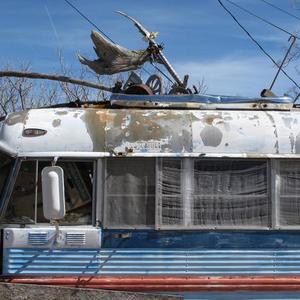

Jay Phyfer and his students took many trips to Arizona for workshops. This image is from one of those trips. (Photo by Jay Phyfer)
When Virginia Intermont College closed in 2014, Bristol lost an important institution, and many talented people also lost their jobs. The art and photography departments at VI were once recognized as among the best in the nation. A! Magazine wanted to find out what has happened to these art and photography instructors who were once on the faculty at VI.
Jay Phyfer came to Virginia Intermont College in 1973 from graduate school at Arizona State to teach the photography end of a communications program. When the journalism teacher left, that program ended, but the photography program flourished.
VI established a photography and film major in 1975 and the program grew. At one point the program increased to 90 majors, but they tried to cap the number of majors at 50-60.
Phyfer remained at the college for the next 41 years until it closed in 2014. "VI was my entire teaching career. I did teach a few part-time photo classes at the old Sullins College during my first few years in Bristol. In the "80s and early "90s, I was an active instructor for summer photography classes at Penland School in Spruce Pine, North Carolina.
"I'm completely retired from real work. I'm working on my own photography, spending time at the farm I own out by South Holston Lake, traveling and spending time with my kids," he says.
He came to VI when he was 31 after a post-college time in Mexico at an archeological dig. He didn't enjoy the dig, but he did enjoy being their unofficial photographer. After the dig was over, he went back to school in Illinois to get enough art and photography credits to get into graduate school. Then he went to Arizona State University, Phoenix, for his M.F.A. degree.
Upon graduation, he was offered a job in Buffalo, New York, and one at VI. He chose VI because he liked the idea of being able to create a department the way he wanted. "You can't do that at a university because of all the bureaucracy," he says.
"My time at VI was a good life. The pay wasn't great. I started at $9,500, and it wasn't until my 17th year that I cracked the $20,000 barrier. With the exception of one turbulent year in 1983, I enjoyed, during my first 25 years, a supportive administration that listened. They listened and allowed faculty to experiment and innovate. The faculty was at VI because they wanted to be there, and all programs thrived.
"I was especially blessed when I hired John Scarlata in 1979 and Loran Meares in 1981. Together we built in the "80s one of the largest and most successful photography programs in the Southeast. We always had great students, especially in photography and the arts. And in the "90s President Gary Poulton successfully brought VI salaries up to the level of neighboring schools similar to VI," Phyfer says.
Phyfer and his colleagues had many students who went on to win prizes, such as Preston Gananway who won a Pulitzer Prize for her photography; Jeffrey Allison who works for the Virginia Museum of Fine Arts; and Paul Estabrook who is a street photographer in South Korea. Estabrook's work has been published in Burn Magazine and LensCulture and won awards including the Magnum Photography Award.
Phyfer is just as proud of the students who are still in the area and continue their photographic work.
Some examples of those students are Carlo Olsen and Ben Dowdey who run the photography studio at Eastman Chemical. Jeff Sturgill has a studio in Kingsport, Tennessee, and specializes in portraiture. Billie Wheeler works at Barter Theatre. John Cornelius was one of Phyfer's first students and is a photographer in Abingdon, Virginia.
Phyfer knows where his former students are through a photography alumni Facebook page. There are more than 600 alumni on this site.
Since he's retired, Phyfer is enjoying his personal photography. "I still do black and white, and color. I shoot a lot of landscapes, but I really enjoy just photographing all the idiosyncratic stuff that we as people create. It's almost a documentary of our idiosyncrasies. That's a lot of my work."
He's also shooting color photos using a wooden pinhole camera from Hong Kong manufactured by Zero. Apinhole camerais a lightproof box with a small hole in one side. Light from a scene passes through the aperture and projects an inverted image on the opposite side of the box.
"I'm just doing things I'm interested in. I've never been much of a portrait shooter. I like to wonder around by myself on the land or in towns. I like to document things. I enjoy being able to work on my own work. Next year I'm going back to Arizona and probably back to Mexico. I like to photograph that culture," Phyfer says.
To see more of his work, visit www.phyfer.com.
THERE'S MORE
Marvin Tadlock a part of VI for 42 years